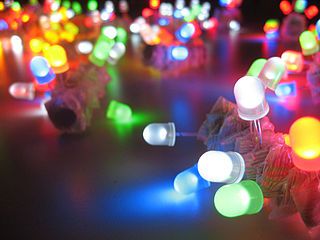From Guest Blogger Danielo: The LED Revolution: A Bright Idea

Photo credit: Orphek — http://www.orphek.com
Initially just an innovative way to provide the lights on indicator lamps and remote controls, and then developed into an exciting way to add colour to interior design projects and modern venues, the light emitting diode is now wending its way through the lighting market on an eco-warriors mission to replace the standard incandescent bulb.
Industry and large businesses have been catching on to the environmental and practical benefits of LED bulbs for a while now, but were afraid to make the transition as it seemed like a whole lot of extra work and expense to replace incompatible standard light fittings.However, it is now possible to retro-fit LED lighting into most standard fittings with the development of the LED GU10, a flag-bearer for the retrofit market, and subsequent retrofitting solutions. If a business was to switch all of its lighting to LED bulbs it would save 90% of the energy currently used by standard bulbs. Now, while the initial cost of LED lighting is high, the economic gain over several years will be notable, and with such a heavy focus on social responsibility, most businesses are looking to find practical solutions to reduce their environmental impact. If LEDs are accepted on such a large scale among businesses, industries and in the commercial and public sphere, it will be a very positive step towards phasing out incandescent bulbs entirely.
Lighting manufactures across the globe will begin to phase out the old standard bulbs with an aim to have stopped their fabrication entirely by 2017. Switzerland and Australia actually began the phase out in 2008 by taking severe measures and completely banning the further production of inefficient incandescent lighting. Following the EU directive to reduce energy use by lighting, the UK began its ban in 2009, but an increased use of halogen down lighting actually counteracted any notable energy reductions and will continue to do so until LED down lighting becomes the norm. In September 2012, the final plug was pulled on incandescent lighting, when retailers were officially banned from selling the remaining 25W and 40W bulbs. With the options becoming limited, people will be forced to turn to more energy efficient lighting, and those who do not approve of the dimly glowing CFL bulbs will be encouraged by the sharp brightness of LEDs. Not only do the latter provide an instantaneous and bright light, but it does not emit any heat, does not contain any harmful gases and will ultimately be a much safer and long lasting alternative to Edison’s century old light bulb.
At 11.59pm on the 31st December 2012, an epic sphere of LED bulbs transfigured to create a dazzling display of light, pattern and colour, was lowered atop Number 1, Times Square, New York. This was another spectacular event, part of a century old tradition which has recently taken a step towards meeting the needs of our increasingly environmentally conscious society. The 32,256 energy efficient LED lights will glow all year round atop the 2013 banner as a beacon of innovation and hope for a greener future.

“If a business was to switch all of its lighting to LED bulbs it would save 90% of the energy currently used by standard bulbs.”
Ignoring the grammar problem, I do not believe it!!
Businesses use mostly fluorescent tube lighting and the difference in efficiency between LED bulbs and classic fluorescent tubes is quite small. Surely a business would not replace fluorescent tubes with LED bulbs since doing so would be a major project. If it becomes reasonable to replace fluorescent tubes with LEDs, then businesses would probably use LED assemblies which are designed to fit fixtures which currently use fluorescent tubes; such LED assemblies are currently available.
It is possible that if a typical American home replaced its incandescent lighting with LED bulbs it would reduce the energy used for lighting by more than 80%. Whether the cost of doing so could yet be justified is questionable; it might be more reasonable to replace incandescent bulbs with CFLs. In any case, incandescent bulbs should not be used in situations where they are on for extended periods of time.
It will be unfortunate if incandescent bulbs are completely phased out since there are places where only incandescent bulbs make sense. For example, in closets the total burning time each day would rarely exceed five minutes and closet lights are turned on and off quite frequently. Thus, the interest on the investment for LED bulbs would greatly exceed the amount saved. The life of CFLs is greatly shortened when they are frequently turned on and off so if CFLs were used in closets, their life would probably be shorter than the life of incandescent bulbs. With a google search, one can find information quantifying how much turning CFLs on and off reduces their life.
One must use some judgement to determine where LEDs, CFLs, and incandescent bulbs are used. Using only one kind of light source makes no sense.